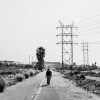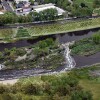The Bowtie Offers a Rare Refuge Along the L.A. River

Published in partnership with Clockshop, "South of Fletcher: Stories from the Bowtie" looks at Los Angeles’s greatest challenges and opportunities: the housing crisis, lack of open space, effects of climate change, and forces of urban development. This unassuming, seemingly abandoned site along the Los Angeles River pulls everything into focus. The future of the Bowtie Parcel, once one of Southern California’s most important railroad yards, is being discussed right now. "South of Fletcher: Stories from the Bowtie" aims to diversify the voices being heard by listening to the people who know the Bowtie — what it was, what it is, and who care about what it will become.

“Growing up, I had a lot of shit that I had to put up with and deal with and take care of,” Mykey told us one of the very first times we met.
After his parents died when he was young, he grew up with his aunt in Cypress Park.
Around 10 years ago, when he was still in high school, Mykey and his brother would ditch class sometimes and wander around — and that’s how he first discovered the Bowtie.
“Now a lot of that weight has come off, and I’ve found this place over here,” he told us, gesturing to the emptiness and quiet he finds when he’s out at the site. “So this place actually has been… It’s comfortable out here, you know?”

When he’s not picking up shifts at restaurants, or in the fields, as part of a temporary harvesting crew, Mykey is somewhere between his aunt’s house and the Bowtie, painting — on canvas, paper, or on the old rail yard ruins and bridges around the Bowtie and along the L.A. River.
This summer, Mykey took us along for a street art tour of the site.

We started under the Fletcher Drive Bridge, in front of the concrete supports that used to be covered with street art. Mykey told us that some of the art was created by famous artists. “But six years ago, they started buffing all that out,” he said.
Cleaning contractors regularly cover up the graffiti with beige or gray-colored paint, which of course then creates a new, clean canvas that often gets decorated with colorful spray paint within days, before eventually getting buffed again, and so on. The street artists and city workers are locked in a ridiculous game of cat and mouse.
We walked along the old road that cuts through the middle of the Bowtie, where there's graffiti everywhere we look: on the asphalt below us, on light poles and even on a few tree trunks.
Mykey's own tag adorns a cargo container. It’s made up of the letters M and Y, followed by an upright vintage-looking key. Another conspicuous tag at the Bowtie simply reads THOR.
“That right there is my homey,” said Mykey. “I’ve known him since middle school. He’s like two years younger than me.”
The graffiti here differs from tags that signify gang activity — the kind that’s feared by residents of the Pocket, located next door to the Bowtie.

Mykey is not affiliated with gangs, though gangs do run around here. He’s part of a community of people — most of whom are men in and out of homelessness, living in tents and in makeshift structures near the Bowtie and along the river, and who are actually very supportive of one other.
“Sometimes you’re not alone, because you meet all kinds of people out here and you get to share experiences,” said Sergio Herrera, a big and tall, gentle guy, and a friend of Mykey’s. “Yeah, there’s some partying going on, too. It’s a fun place to be.”
When we met, Sergio had been estranged from his family, homeless for about a year, and struggling with depression.
Sergio told us that he abides by the rules of living in this community — things like, don’t burn anybody, don’t go into another person’s space without permission, and stay at peace with your neighbors.

But the reality of living on the streets also means having to set up camp in different places, staying away from the cops, and going back to the so-called “real world” outside the Bowtie for stretches of time.
That's one of the things the Bowtie represents today. It’s a popular place for anyone from any walk of life to find refuge in. In the not-too-distant future, once the site is cleaned up and landscaped, that might change.
“It’s one of those places in L.A. that are probably going to disappear,” Mykey said when we last saw him at the end of the summer. “And it sucks, because it’s one of the few places left that are probably like this.”
Mykey is hopeful, though. Maybe the Bowtie will be the kind of park that allows graffiti. It could be the kind of open space that retains its urban grittiness. It could even be a space where homeless people can hang out without being frowned upon.
Top Image: The old roundhouse at the southern tip of the Bowtie is a popular proving ground for local street artists | Photo by Bear Guerra
More photos from this project are on view at Occidental’s Weingart Gallery through November 4, presented by Oxy Arts.
The South of Fletcher podcast is live now. New episodes are released bi-weekly on Clockshop and on Apple Podcasts.



















